Governor Kim Reynolds approved plans last year to spend federal COVID-19 relief funds to upgrade the technology in her conference room, state records show.
The Office of Chief Information Officer (OCIO) paid vendor AVI Systems $67,543.48 in December for unspecified “IT Equipment and Software” and “IT Outside Services.” Published reports and searchable databases do not reveal that those purchases benefited the governor’s office. But documents Bleeding Heartland obtained through public records requests indicate that the spending covered new audio and video equipment installed in the Robert Ray Conference Room, which is part of the governor’s office suite.
Records also show the payments were supposed to come out of Iowa’s Coronavirus Relief Fund, a pot of federal money established under the March 2020 Coronavirus Aid, Relief and Economic Security (CARES) Act.
OCIO may have tapped a different funding source later to cover the conference room upgrade, as happened with a $39,512 project to migrate the governor’s office computers from Google suite to Microsoft Office 365 last year. Entries on the state’s online checkbook, totaling $67,543.48 to AVI Systems on the same December dates, do not mention the Coronavirus Relief Fund.
The governor’s spokesperson Pat Garrett ignored six inquiries over a two-week period. OCIO’s public information officer Gloria Van Rees also did not respond to eight messages during the same time frame seeking to clarify what funding stream paid for the conference room upgrades, and whether the governor’s office reimbursed OCIO for the payments to AVI Systems, as happened following the Office 365 migration.
PROJECT ADDED TO OCIO’S CARES ACT REQUESTS LAST SUMMER
The governor’s chief operating officer Paul Trombino met with an OCIO employee in March 2020 to discuss desired upgrades for the Ray Conference Room. AVI Systems submitted a proposal in May to provide a system “capable of Voice conferencing, Software based video conferencing, Resident PC presentation, Guest Laptop connections, and wireless presentation capability” at an estimated cost of $64,369.55. Trombino confirmed in early June, “we plan to move forward” with the project.
Chief Information Officer Annette Dunn didn’t mention any equipment for the governor’s office in the “high level” CARES Act funding request she submitted to Reynolds’ chief of staff Sara Craig Gongol and Trombino last May. Those expenses reflected a mix of OCIO projects; some were clearly related to COVID-19, while others had no obvious connection to the pandemic.
A larger, formal request from Dunn to Reynolds adviser Joel Anderson in July included two line items for projects in the governor’s office to be financed through the CARES Act: $65,000 for “Ray Room Technology” and $73,000 for “IGOV O365 Conversion.” Those two proposals were grouped with OCIO’s $3.8 million request for “pandemic technology needs” during the fall and winter of the 2021 fiscal year.
Under guidance the U.S. Treasury Department released last year, states and local governments were allowed to use CARES Act funding to cover “necessary expenses incurred due to the public health emergency,” which were “not accounted for” in the most recent budget and arose between March 1 and December 31, 2020. Dunn’s cover letter to Anderson asserted that the $65,000 requested “will cover the cost of the technology added to the conference room by OCIO for COVID remote press conferences.”
It’s a stretch to call that a necessary expenditure related to the pandemic. Reynolds held most of last year’s press conferences about COVID-19 at either the State Emergency Operations Center or the Iowa PBS studios in Johnston. She occasionally scheduled media availabilities at private businesses or non-profit offices around the state. The request for bids OCIO posted in September didn’t mention COVID-19, saying “The equipment is needed to give the conference room an A/V upgrade and enhance its capabilities.”
Dunn’s justification for using CARES Act funds to move the governor’s office computers to Office 365 was even more flimsy: “The request will Provides analytics need in scheduling.”
Reynolds has sole authority to approve Coronavirus Relief Fund spending and allocated funds to OCIO for both projects designated for her office, as part of “Capitol Complex Network Upgrades.” Two vendors bid on the Ray Conference Room project; OCIO selected AVI Systems.
RECORDS SHOW FEDERAL COVID-19 FUNDS DESIGNATED FOR PROJECT
Numerous records point to CARES Act funds being used for the conference room upgrade. A half-dozen state agencies submitted a “COVID Programs tracker” each week to the governor’s office last fall. OCIO’s reports consistently listed “Ray Room Technology” as one of the agency’s COVID-19 relief programs (see here, here, and here). A graphic on CARES projects sent to the governor’s staff in early October described the conference room upgrade as “in progress.”
After the governor’s staff asked agencies to confirm that CARES Act funds would be spent by the end of the calendar year, as federal law then required, OCIO reported in November that the Ray room equipment had been ordered and an installation scheduled for the week of December 7.
I took this screenshot from a large spreadsheet showing OCIO expenditures during the 2021 fiscal year. The numbers are hard to read, but you can make out five payments totaling $67,543.48 to AVI Systems. All are labeled “COVD,” which is the code for all expenses paid with CARES Act funds.
In addition, the state Department of Management’s Iowa Pandemic Recovery Report Payment Explorer lists twelve payments totaling $67,543.48 to AVI Systems, disbursed on either December 15 or December 16. All show OCIO as the state department and the Coronavirus Relief Fund as the federal program that financed the expenditures. Screenshots are enclosed below as Appendix 1.
On December 16, Dunn informed the governor’s adviser Anderson, “Ray Room is completed and paid.” The conference room and Office 365 migration projects were still listed among the OCIO’s projects funded through the CARES Act on a document sent to the governor’s staff in January 2021.
Reynolds continued to hold her occasional COVID-19 press conferences at Iowa PBS studios until early May.
A PATTERN OF OFFLOADING EXPENSES WITH LITTLE TRANSPARENCY
Having OCIO pay for the conference room project and the software migration is consistent with Reynolds’ leadership style in two ways. Pushing some of her office’s operating expenses onto other agencies allows the governor to keep an expanding, well-paid staff her budget allocation could not otherwise support.
In addition, running CARES Act money through OCIO (instead of allocating it directly to the governor’s office) reflects a lack of transparency that has become a Reynolds administration hallmark. Last year, the governor used federal COVID-19 relief funds to cover part of her personnel costs. Yet no one searching publicly available data, payment trackers, or published reports on Iowa’s Coronavirus Relief Fund would find any trace that the governor’s office received a dollar.
Instead, the $448,449 used to compensate 21 of Reynolds’ permanent staffers came out of a $1 million CARES Act allocation to the Iowa Department of Homeland Security and Emergency Management. I had to submit public records requests to three agencies to find out how and when the Homeland Security department transferred those “State Government COVID Staffing” funds. I also asked the governor’s office for related documents last September, but Reynolds’ designated records keeper, legal counsel Michael Boal, never acknowledged the request. (The governor’s staff have not complied with Iowa’s open records law for more than a year.)
“CODING” VERSUS SPENDING FROM THE CARES ACT
Bleeding Heartland reported exclusively in March on records indicating that $39,512 in federal COVID-19 relief funds were spent on the software migration project before the governor’s office reimbursed OCIO for that expense. Reynolds’ spokesperson Garrett objected to the post, saying “No CARES Funding was ultimately used.”
Nevertheless, the state’s Pandemic Recovery Report Payment Explorer continued to attribute that payment to the Coronavirus Relief Fund. OCIO’s Van Rees told me in April that the vendor selected for the Office 365 migration
was paid out of OCIO’s general fund. The initial payout from OCIO was coded by DAS [Department of Administrative Services] as Coronavirus Relief payment, as there was initial information that is where funds would be reimbursed from. However, OCIO was not reimbursed using CARES funding by IGOV. We are working with DAS to change the coding to appropriately reflect the funds. Once the coding is changed there will be no reference to CARES funding on any part of the transaction.
Van Rees explained further in an April 14 email,
The state checkbook does not illustrate a bank account from which funds are withdrawn. It illustrates coding to federal and state programs to keep track of monies across multiple state agencies. In this instance it illustrates how the payment was inaccurately coded to the federal CARES program in November. The payment from the OCIO general account was coded correctly for the information we anticipated at the time. The coding for the expense became incorrect when we were not reimbursed with funds coded as CARES funding. As the coding is now incorrect, we are processing a correction to appropriately reflect the proper vector of the funds. This is not uncommon, and the correct and responsible course of action is to process a correction document to move the expense from CARES funds to OCIO operating funds. This process leaves the original transaction intact and will create new entries to remove the expense from CARES funds and add the expense to the OCIO operating funds. After the correcting transaction is processed, the net result will be that it will no longer tabulate as a CARES expenditure.
The Iowa Department of Management’s Linda Leto later clarified on April 23,
Money is transferred from the Iowa Coronavirus Relief Fund (ICRF) fund to a state agency. […] The agency then makes payments to vendors. Payments to vendors are not made directly from the ICRF fund.
The federal program is called the Coronavirus Relief Fund, and that is what is referenced on the payments to vendors. It is not the fund the transactions were paid from. They are just coded to associate the transaction with CFDA 21.019, Coronavirus Relief Fund (the federal program associated with the grant we received).
Strangely, in mid-June the pandemic payment explorer still listed that $39,512 payment as coming from the CARES Act. I circled back with Van Rees: would the database ever be corrected? She replied on June 17,
The amount in question was corrected. The correct entry can be seen on the State Checkbook, an image of which is attached to this email. According to DAS, the pandemic resources site website reflects vendor payments, it will not reflect correction document filings.
Here’s the image she attached.
Now I had more questions. When did officials make that correction on the state checkbook? Does the pandemic resources site list any other payments by OCIO that appear to come out of the Coronavirus Relief Fund but actually came out of a different account? If so, which ones?
Van Rees told me on June 21 that according to the Department of Administrative Services, the state checkbook was updated on April 30. Regarding my other questions, she advised me to submit a new public records request to OCIO.
That could take weeks, if not months. I had found some documents on the conference room project among more than 700 pdf files OCIO sent me earlier in the year. So I plugged AVI Systems into the state checkbook. Lo and behold:
The “Checkbook” tab showed the same twelve payments to AVI Systems, occurring on the same dates in December.
It looked like someone in the governor’s office or OCIO had nixed the plan to use COVID-19 relief money for the Ray room upgrades. I had more questions: When did the state checkbook entry change? Did the governor’s office reimburse OCIO for the expense? If not, what funding stream covered the costs? Radio silence from Van Rees, who apparently wants me to submit another records request.
I also sought clarification from Garrett. Did the governor’s office decide not to use CARES Act funds for this project? If so, who made that call, and when? (I knew OCIO officials had forwarded my initial records request from December to Garrett and to Trombino right away.)
Did the governor’s office reimburse OCIO for payments to AVI Systems, as it did with the payments for the Office 365 migration? If so, where did those funds come from, and when did the reimbursement happen?
More than two weeks later, I haven’t heard back. I’ll update this post as needed.
P.S.- For those who think it’s no big deal to direct COVID-19 relief funds toward fancy A/V equipment for the governor’s conference room: it was a weeks-long scandal when Governor Chet Culver’s administration spent $19,000 on carpet for the office that coordinated flood relief efforts.
Using CARES Act funds for high-tech items on Paul Trombino’s wish list is a red flag, especially since goods and services purchased by OCIO can’t easily be tracked as going to the governor’s office. Unfortunately, Republicans who control the Iowa House and Senate have abandoned the concept of executive branch oversight.
Appendix 1: Screenshots from the Iowa Pandemic Recovery Report Payment Explorer showing CARES Act payments to AVI Systems. Other records indicated these purchases were for technology upgrades in the governor’s Robert Ray Conference Room.
Appendix 2: Screenshot from the State of Iowa Checkbook, showing $67,543.48 from OCIO to AVI Systems (click here to view the itemized list of twelve payments)
Top image: Flat screen and camera mounted on the back wall of the Robert Ray Conference Room in the governor’s office at the Iowa state capitol. Photo by Laura Belin, taken before Governor Kim Reynolds’ news conference on June 23, 2021.

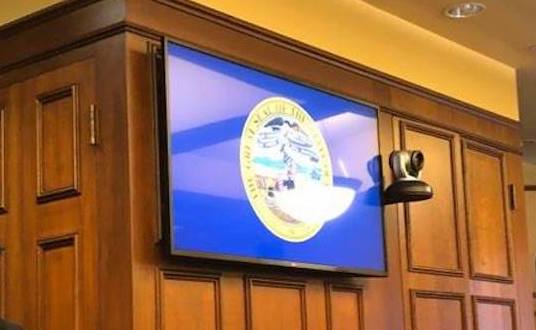

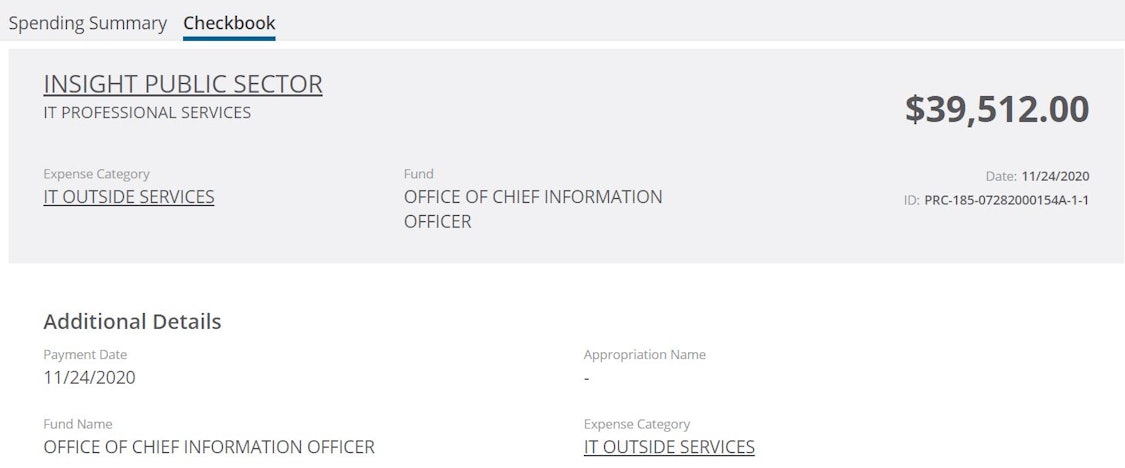
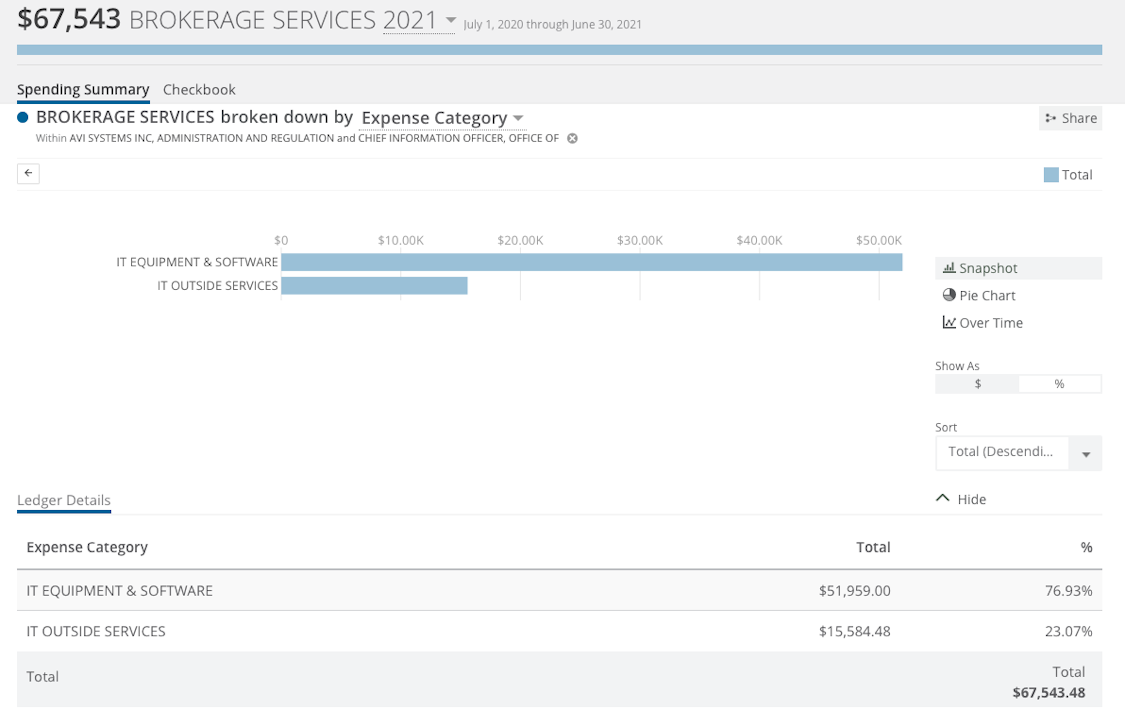
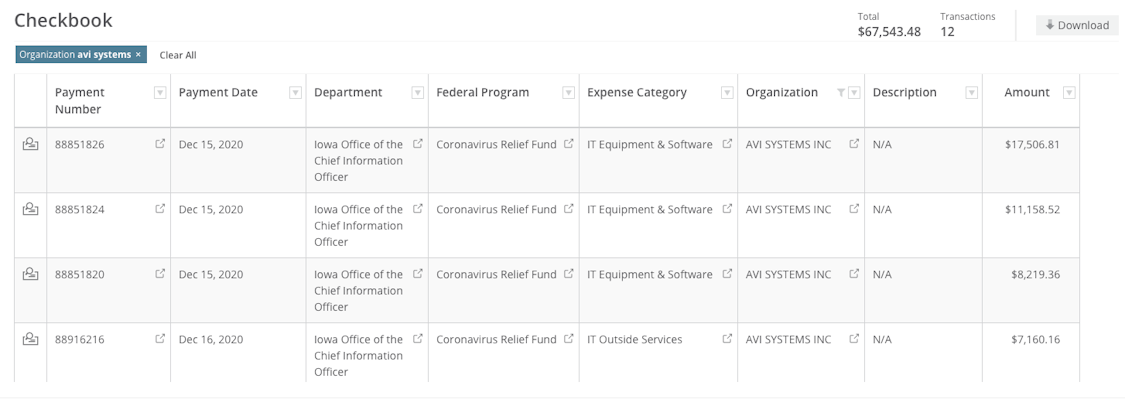
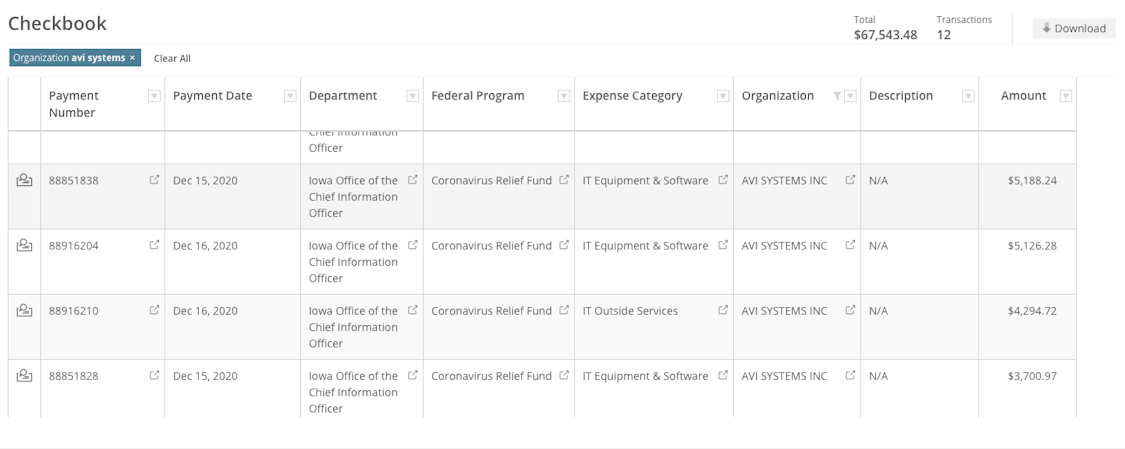
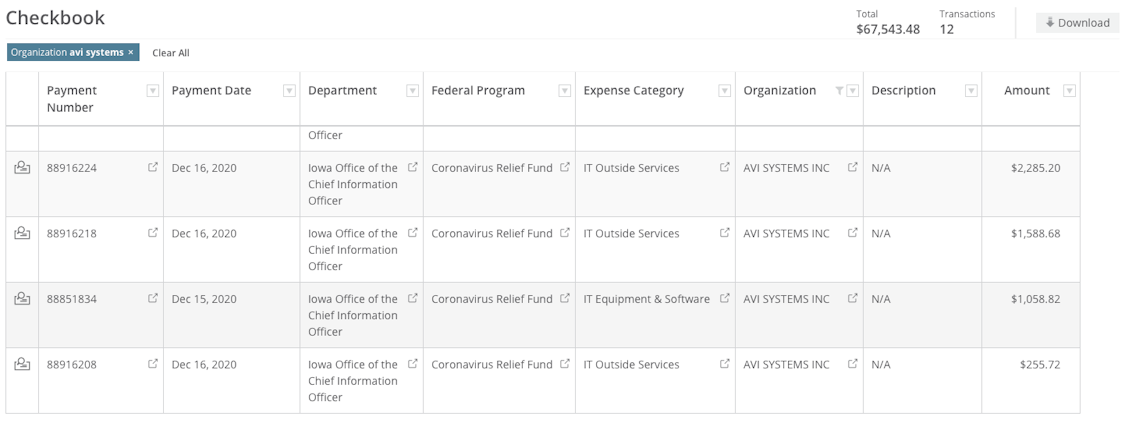
4 Comments
Technology in the Capitol
A better case could have been made to justify major technology improvements at the Capitol to support public access and participation in decision-making, safer committee meetings, and interactions between legislators and between legislators and constituents. How much did the General Assembly receive or request for these purposes?
openureyes Mon 12 Jul 12:13 PM
yes, absolutely
OCIO spent a lot of money on technology that was clearly related to the COVID-19 pandemic. That would have been a good use.
There was a legislative request, I think, but I need to go back to see what it was.
Laura Belin Mon 12 Jul 2:28 PM
Ashton?
Reading this I feel like we’re all caught in one of Mr. Kutcher’s episodes of Punk’d.
As a former (pre-Gannett) Register reporter, I thank you for this epic piece of investigative reportage. Your move Dems….
dbmarin Mon 12 Jul 12:51 PM
unfortunately
Democrats are not in a position to convene the oversight committees. That would be the next logical step.
Laura Belin Mon 12 Jul 2:29 PM